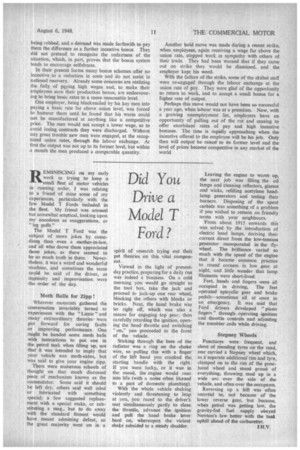Did You Drive a
Page 35

If you've noticed an error in this article please click here to report it so we can fix it.
Model T
Ford?
REMINISCING on my early work in trying to keep a small fleet of motor vehicles in running order, I was relating to a friend of mine some of my experiences, particularly with the few Model T Fords included in the fleet. My friend was amused but somewhat sceptical, looking upon my anecdotes as exaggerations, or " leg pulls."
The Model T Ford was the subject of more jokes by comedians than even a mother-in-law. and all who drove them appreciated those jokes, as there seemed to be so much truth in them. Nevertheless, it was a weird and wonderful machine, and sometimes the same could be said of the driver, as ingenuity and improvisation were the order of the day.
Moth Balls for Zipp Wherever motorists gathered the conversation invariably turned to experiences with the " Lizzie " and many extraordinary theorieswere put forward for curing faults or improving performance. One might be handed some moth balls with instructions to put one in the petrol tank when filling up, not that it was intended to imply that your vehicle was moth-eaten, but was said to give your engine zipp.
There were numerous schools of thought on that much discussed piece of mechanism known as the commutator. Some said it should be left dry, others said well oiled or lubricated with something special; a few suggested replacement with a special make, or substituting a mag., but to do away with the standard fitment would have meant admitting defeat, so the great majority went on in a spirit of research trying out their pet theories on this vital component.
Viewed in the light of presentday practice, preparing for a daily run was indeed a business. On a cold morning you would go straight to the tool box, take the jack and proceed to jack-up one rear wheel, blocking the others with blocks or bricks. Next, the hand brake was let right off, Which was also a means for engaging top gear; then carefully retarding the ignition, opening the hand throttle and switching
on," you proceeded to the front of the vehicle.
Sticking through the base of the radiator was a ring on the choke wire, so pulling this with a finger of the left hand you cranked the starting handle with the right. If you were lucky, or it was in the mood, the engine would roar into life (with a noise often likened to a part of domestic plumbing).
With the whole vehicle shaking violently and threatening to leap at you, you raced to the driver's seat simultaneously partly to close the throttle, advance the ignition and pull the hand brake lever hard on, whereupon the violent shale subsided to a steady shudder. Leaving the engine to warm up, the next job was filling the oil lamps and cleaning reflectors, glasses and wicks, refilling acetylene headlamp generators and testing their burners. Disposing of the spent carbide was something of a problem if you wished to remain on friendly terms with your neighbours.
From about 1915 onwards this was solved by the introduction of electric head lamps, deriving their current direct from the low-tension generator incorporated in the flywheel. The brilliance varied so much with the speed of the engine that it became common practice to round corners in low gear at night, and little wonder that lamp filaments were short-lived.
Feet, hands and fingers were all occupied in driving, The feet operated epicyclic gear and brake pedals—sometimes all at once in an emergency. It was said that Ford drivers developed "piano fingers" through operating ignition and throttle controls and adjusting the trembler coils while driving.
Stepney Wheels
Punctures were frequent, and short of mending tyres on the road, one carried a Stepney wheel which, as a separate additional rim and tyre, clamped on to the rim of the punctured wheel and stood proud • of everything; throwing mud up in a wide arc over the side of the vehicle, and often over the occupants.
Reversing up a hill was often resorted to, not because of the lower reverse gear, but because, when petrol was getting low, the gravity-fed fuel supply obeyed Newton's law better with the tank uphill ahead of the carburetter.




















































































